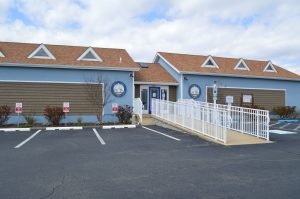
FENWICK ISLAND – Officials in Fenwick Island say they will continue to explore solutions to flooding and sea level rise.
Last week, members of the Fenwick Island Infrastructure Committee met with representatives from the Delaware Department of Natural Resources and Environmental Control (DNREC) to discuss what actions the town is permitted to take to address flooding and sea level rise. Councilman Richard Benn, committee chair, said a recently conducted resiliency study recommended the town raise its bulkheads in the coming years.
“That resiliency study recommended raising all bulkheads and probably requiring us to put in bulkheads where there’s some existing riprap,” he said. “So I know we would like to do that, especially on our public properties, where our street ends are. So what do we have to do?”
In March, the infrastructure committee received its first presentation of a town-wide resiliency study, which not only identified recent and ongoing resiliency initiatives, but proposed actions to alleviate flooding.
As part of the study, consultant AECOM made several recommendations to address flooding and sea level rise. Short-term tasks include updating town codes and working with state and local agencies, while long-term tasks include elevating streets, homes and bulkheads.
The subject of bulkheads also highlighted a recent informational meeting, in which infrastructure committee members received input on the study. Several community members questioned the town’s plans for raising bulkheads, or if bulkheads could even be added behind existing riprap.
Back on the committee’s agenda last week, Benn told DNREC representatives he was seeking information on the town’s ability to replace or add bulkheading. He noted that some properties had bulkheading, some had riprap, and some had nothing at all.
“Because we have very small areas to work in, and it’s really not feasible to bring the bulkheads inland of the existing riprap, we’re actually going to have to remove some of the existing riprap,” he said. “I just wanted to ask whether or not we can do that. Obviously, all of this stuff requires permits.”
DNREC’s Matt Jones said the town’s ability to add or replace bulkheads was dependent on if the property was located on a natural body of water, such as the Little Assawoman Bay, or on a lagoon. He said bulkheads on natural waterbodies could be replaced in-kind or, in rare instances, up to 18 inches channelward.
“If there’s not a bulkhead there, our regulations actually prohibit us to allow new bulkhead on natural waterbodies,” he added. “That being said, we do jurisdictional determinations, where we mark the mean high waterline and from there a lot of people end up putting in what they call a retaining wall … which is basically a bulkhead but by definition is landward of the mean high water line. So it’s out of the state’s jurisdiction at that point. Being honest with you, eventually it will become a bulkhead over time because of erosion.”
For properties located on lagoons or canals, Jones said repairs and replacements are approved through an expedited approval process. He said bulkheads can be replaced in-kind or built up to 18 inches channelward.
“However, in a lagoon, if you have unstabilized areas of a lagoon that doesn’t have a bulkhead, but the rest of the lagoon is greater than 75% bulkheaded, you would qualify for bulkhead to be aligned in-kind with the rest of the surrounding bulkheads in that community,” he explained.
Committee member Tim Bergin asked DNREC representatives about bulkhead heights. Jones said DNREC had no height requirements.
“For us, we don’t have a vertical elevation requirement,” he replied. “Truthfully, if you wanted to go 20 feet you could.”
When asked what other communities were doing to address bulkheads, Jones said he did not know of any other towns taking on the issue.
“You guys are one of the first communities I’ve heard trying to tackle this issue, which is good,” he said. “It’s a conversation that needs to come to the forefront.”
During public comments, resident Bill Weistling, former chair of the infrastructure committee, shared his concerns regarding plans to raise bulkheads. He said issues such as cost and participation needed to be addressed.
“What will happen if some property owners refuse to raise their bulkhead?” he asked. “For this concept to work, I think everybody’s got to participate in it. I don’t know if it’s possible if you can force them to do it.”
Weistling also noted that raising bulkheads would impact access to boat docks. He added that raising bulkheads could also hurt bayside properties during major storms.
“If you do raise the bulkheads – and I’m not sure how high you’re talking – have you considered what would happen if, God forbid, if the ocean ever breaks through?” he asked. “The people on the bayside would be devastated because the bulkheads would prevent that water from escaping.
Benn said those questioned would need to be addressed as the committee and property owners explored the idea of raising bulkheads.
“It’s a process,” he said. “The good news is, we have time. That bad news is, it’s coming.”

